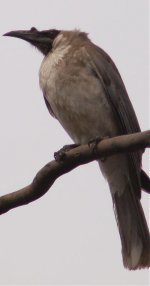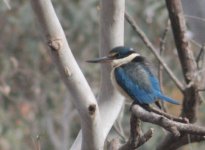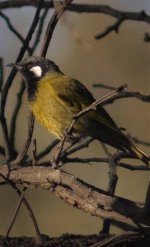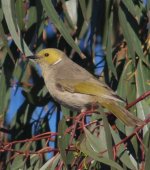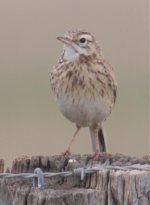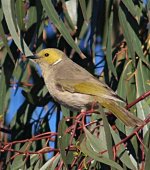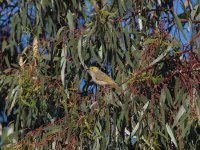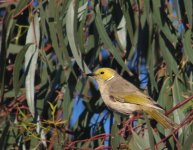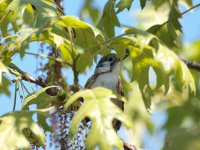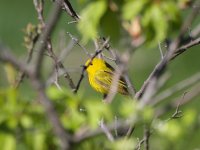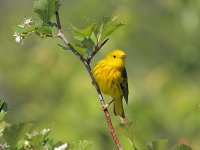In a previous thread someone requested some sample shots from my E-520 with 300mm Asanuma manual focus lens. Here are a few, and apologies if I haven't uploaded them correctly.
I've cropped them to be no more than 900 wide, no resizing, and I don't think I've enhanced them at all. Now that I try to do an upload, I see the max size is 1024 x 800, but never mind. I chopped some tails off to get them down to 900 wide. I also notice that the upload process removes the EXIF information, pity that.
They are, from left to right:
1. Noisy Friarbird, ISO 400 (Goulburn, NSW)
2. Sacred Kingfisher, ISO 800 (Goulburn, NSW)
3. White-eared Honeyeater, ISO 800 (Goulburn, NSW)
4. White-plumed Honeyeater, ISO 200 (Melbourne, Victoria)
5. Richard's Pipit, ISO 400 (Western Treatment Plant, Victoria)
Some low ISO shots would be better for seeing how good a lens is, but these sorts of speeds are what I will end up using the lens on. I think the White-plumed Honeyeater is the sharpest, and none have very bad fringing, although I'd like to hear what faults others can find. All of them are probably suffering from at least some focusing inaccuracy.
Most were taken wide open at f5.5, but by the time I got around to the White-plumed Honeyeater I was experimenting with f8, and I think it has improved the shot. Bear in mind too that I'm still learning how to use both the lens and the camera, so they aren't as good as they could be.
I'm kind of happy with the quality, especially for the price, but not with the reach. The kingfisher is the best example of that, being the most distant shot, but is ISO 800 so a bit fuzzy anyway.
In my opinion that sharpness doesn't match my Canon S3 with 1.7x teleconverter, so I'm in the process of buying a 400mm lens to see if I can remedy that. Although it feels like a backward step to upgrade to an SLR and lose reach at the same time, the number of focused behind-vegetation shots I'm getting compared to before is good compensation. The other problem before was simply finding the bird using the grainy EVF, and that isn't that much of a problem anymore either.
In my opinion, combining an SLR with a cheap MF lens is probably the most cost effective way to get into bird photography - if your eyes can cope with manual focusing, and if you have enough experience to buy the right lens off eBay, etc. It probably works out cheaper than a good compact megazoom, and you probably need to add a teleconverter to most of them anyway.
Such a pity that as they increase the zoom factors, they also make the short end of the range even wider. Bloody landscape photographers.
I've cropped them to be no more than 900 wide, no resizing, and I don't think I've enhanced them at all. Now that I try to do an upload, I see the max size is 1024 x 800, but never mind. I chopped some tails off to get them down to 900 wide. I also notice that the upload process removes the EXIF information, pity that.
They are, from left to right:
1. Noisy Friarbird, ISO 400 (Goulburn, NSW)
2. Sacred Kingfisher, ISO 800 (Goulburn, NSW)
3. White-eared Honeyeater, ISO 800 (Goulburn, NSW)
4. White-plumed Honeyeater, ISO 200 (Melbourne, Victoria)
5. Richard's Pipit, ISO 400 (Western Treatment Plant, Victoria)
Some low ISO shots would be better for seeing how good a lens is, but these sorts of speeds are what I will end up using the lens on. I think the White-plumed Honeyeater is the sharpest, and none have very bad fringing, although I'd like to hear what faults others can find. All of them are probably suffering from at least some focusing inaccuracy.
Most were taken wide open at f5.5, but by the time I got around to the White-plumed Honeyeater I was experimenting with f8, and I think it has improved the shot. Bear in mind too that I'm still learning how to use both the lens and the camera, so they aren't as good as they could be.
I'm kind of happy with the quality, especially for the price, but not with the reach. The kingfisher is the best example of that, being the most distant shot, but is ISO 800 so a bit fuzzy anyway.
In my opinion that sharpness doesn't match my Canon S3 with 1.7x teleconverter, so I'm in the process of buying a 400mm lens to see if I can remedy that. Although it feels like a backward step to upgrade to an SLR and lose reach at the same time, the number of focused behind-vegetation shots I'm getting compared to before is good compensation. The other problem before was simply finding the bird using the grainy EVF, and that isn't that much of a problem anymore either.
In my opinion, combining an SLR with a cheap MF lens is probably the most cost effective way to get into bird photography - if your eyes can cope with manual focusing, and if you have enough experience to buy the right lens off eBay, etc. It probably works out cheaper than a good compact megazoom, and you probably need to add a teleconverter to most of them anyway.
Such a pity that as they increase the zoom factors, they also make the short end of the range even wider. Bloody landscape photographers.





